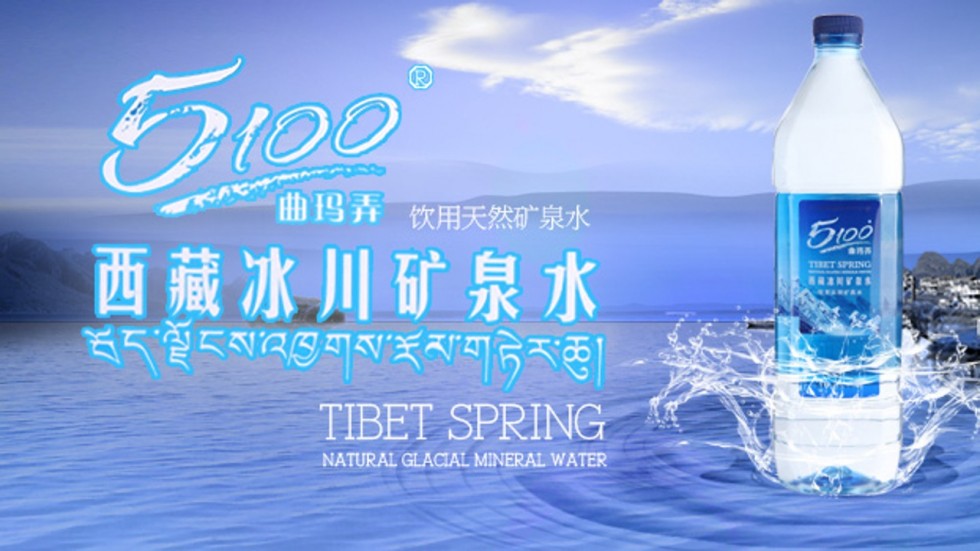 (TibetanReview.net, Sep18, 2017) – Supermarkets in Hong Kong, as elsewhere in China, have in recent years been sporting bottled waters filled from Tibet’s glaciers that are shocking for their unsustainability – in a business that is environmentally deeply problematic to start with, said a commentary posted on hongkongfp.com Sep 17.
(TibetanReview.net, Sep18, 2017) – Supermarkets in Hong Kong, as elsewhere in China, have in recent years been sporting bottled waters filled from Tibet’s glaciers that are shocking for their unsustainability – in a business that is environmentally deeply problematic to start with, said a commentary posted on hongkongfp.com Sep 17.
The commentary, which was by Ilaria Maria Sala, an award winning writer and ceramic artist based in Hong Kong, has particularly referred to the Hong Kong-listed company called Tibet Water Resources founded in 2006 and which produces Tibet 5100, water bottled at the source of the Tibetan glaciers, at 5100 meters of altitude. Shares of this company were reported to trade on the Hong Kong stock market for HK$3.02 at the time of writing. And the company’s latest reports were cited as saying business was good, with a year-on-year expansion of 5%.
Noting that the whole Himalayan region, and the Tibetan part of it in particular, was already under enormous environmental pressure, the commentary said bottling its waters was as absurd as melting icebergs.
Nevertheless, it continued, given the concerns about the safety of food and water in China, and sensing a great business opportunity, provincial government of Tibet Autonomous Region started to open up its springs for industrial exploitation about ten years ago – licensing 28 companies by the end of 2014.
Of them, Tibet Water Resources had expanded the fastest. Its board members are Chinese, including from Hong Kong, with at least one foreigner but not a single Tibetan. Tibet 5100’s ambition is stated to be to produce 10 million cubic metres of bottled water by 2025, and to export worldwide.
Another company, Qomolangma Glacier Company, is said to bottle water just 80 km from Everest Base Camp, in what is supposed to be a national nature reserve, and uses as its brand name the Tibetan word for Everest, with its product not yet being sold in Hong Kong.
The commentary cited Tibet campaign groups as complaining this was just the latest example of a free-for-all in which businesses with strong State backing were being allowed into the Tibetan plateau to mine its resources, with generous government subsidies.
The commentary cited some accounts as saying Tibet 5100 had received US$ 50 million in the years up to 2013 to establish itself, apart from tax cuts, tax holidays and cheap loans.
But Tibetans are said to point out that local people have no part in the decisions that surround the exploitation of this precious resource.
Besides, environmental studies have been said to show that the changes in the flows of water in the Himalayan region, mostly due to artificial dams and industrial exploitation, together with the worldwide rise in temperatures, were contributing to abnormal water patterns downriver. This impacts the countries in South and Southeast Asia which rely on rivers that originate in the Himalayas.
For example, a video circulated online last week showed an apocalyptic river of mud and grass flowing downhill like a sudden volcanic eruption, except that it didn’t glow red with inner fire, but carried its dull black and green mass through a verdant valley in Yushu, Qinghai Province. It was filmed by herdsmen on the plateau and Wang Dekai, chief scientist for disaster prevention in Gansu province, was quoted as saying that permafrost in the plateau had been melting at a faster pace in recent years.
From all this, the commentary said the world was clearly witnessing a rather complex and delicate eco-system showing growing signs of stress. And to presume that China is going to cope well with an expanding presence of industries eager to bottle its waters at the source, in particular in the absence of any environmental impact study published by the water companies, seems foolhardy, it concluded.


